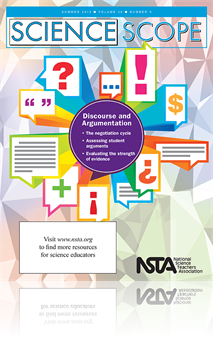All Earth & Space Science resources
Journal Article
Scope on Safety: Earth Science Safety: It's All in Your Form
This column shares safety information for your classroom. This month’s issue discusses safety in Earth science lab activities....
NSTA Kids
Spenser and the Rocks: I Wonder Why
As he begins to discover the interesting rocks all around him, Spenser has many questions about what he finds. Given the differences in the rocks’ colors, sizes, shapes, and textures, there is much to learn about rocks! But that’s not all the cur...
Journal Article
Scope on the Skies: Those Long Summer Days
This column focuses on astronomy throughout the year. This month’s issue discusses viewing the planets in the summertime....
Journal Article
Teaching historical scientific controversies to engage students in discourse and the nature of science....
Journal Article
Using model-evidence link diagrams to weigh alternative models in argumentation....






